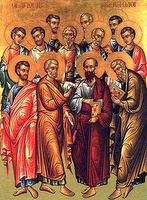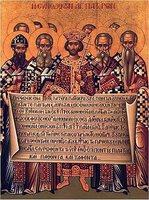Early Christianity
Q: How did early Christians worship and live?
A: Most historians divide Church history into three periods, Ancient (until AD 590), Medieval (590-1517), and Modern (1517-present). Some also are looking to find a logical starting point for a fourth era, citing many changes since the Reformation. We’ll focus on the first 550-odd years. Many think of these as the “Good Old Days” of Christianity, complaining that nothing now is done as it was back then.
 The Apostolic Era lasted until about AD 100, ending with the death of John. Jerusalem, Antioch, Syria, and Ephesus were the centers of the early Church. Roman Christianity was well-established before Peter and Paul died (probably in the mid-60s AD, during Nero’s rule). Acts 8 records the dispersal of the Jerusalem church in AD 44. Before then, Jewish believers there seemingly continued worshiping at the Temple and synagogue study as well as in their homes. They met each Lord’s Day (Sunday) for Christian instruction, worship, and celebration of the Lord’s Supper (Acts 2:42).
The Apostolic Era lasted until about AD 100, ending with the death of John. Jerusalem, Antioch, Syria, and Ephesus were the centers of the early Church. Roman Christianity was well-established before Peter and Paul died (probably in the mid-60s AD, during Nero’s rule). Acts 8 records the dispersal of the Jerusalem church in AD 44. Before then, Jewish believers there seemingly continued worshiping at the Temple and synagogue study as well as in their homes. They met each Lord’s Day (Sunday) for Christian instruction, worship, and celebration of the Lord’s Supper (Acts 2:42).Early Christian writings focused more on doctrine than practice, so we don’t have a full account of what these people did when they gathered. It’s easier to define Apostolic tradition based on the teaching of the Twelve than upon their liturgical practice. We know that they read Scriptures (at first only the Old Testament, since that’s all there was — later came the Gospels and Epistles), pastors preached sermons preached based on Scripture and the words about Jesus, and the early Christians sang “psalms and hymns and spiritual songs. (Ephesians 5:19; Colossians 3:16)” How they defined “hymns” or “spiritual songs” remains a topic for scholarly debate. Church historians think that the early congregations sometimes read of the Epistles as Sunday sermons, perhaps trading them among themselves.
One of the earliest non-Biblical Christian writings is the Didache, a manual of early Church rites and usages and as a handbook of theological interpretation and application. While some scholars doubt its early origins, may are convinced that it was written around AD 100, if not a bit sooner. Considering that it originated in the Church in Syria, quite likely whomever wrote or compiled it quite possibly had direct contact with one or more of Christ’s disciples.
 Heresies plagued the Church even before the Apostles’ deaths; these intensified as eyewitnesses to the Resurrection died out. The Post-Apostolic Era (ca. 100-ca. 170) produced the first historians, who wanted to keep the record straight. The apologists (defenders) of the faith also kept busy. Many of these were persecuted and put to death. Probably the most famous apologist was Justin Martyr. During this time the word “martyr” came to mean not just “witness,” but one who suffered — and, perhaps, died — because of the witness. Justin was one such person.
Heresies plagued the Church even before the Apostles’ deaths; these intensified as eyewitnesses to the Resurrection died out. The Post-Apostolic Era (ca. 100-ca. 170) produced the first historians, who wanted to keep the record straight. The apologists (defenders) of the faith also kept busy. Many of these were persecuted and put to death. Probably the most famous apologist was Justin Martyr. During this time the word “martyr” came to mean not just “witness,” but one who suffered — and, perhaps, died — because of the witness. Justin was one such person.From within the Church, problems included “Judaizers” such as those Paul faced in Galatia. They burdened consciences with legalism rather than allowing the freedom of the Gospel. Paganism and Gnosticism (which taught a higher “secret” wisdom, much as does the modern “New Age” movement) exerted influence from without.
The Ante-Nicene Era (ca. 170-325) saw the Church grow in spite of persecution. Speculation increased concerning the person and nature of Jesus Christ. Defenders of the faith kept busy rebutting those who falsely confessed the Savior or twisted the Scriptures. During this time the Roman state recognized, then supported, and finally adopted Christianity. Most official persecution ended, but government interference increased.
It became easy to call oneself Christian. Christianity was the “in thing.” Many non-believers and hangers-on joined the Church, bringing their own theologies with them. These remained sources of contention. However, the end of persecution brought the blessing of open, formal worship. What had been “underground” worship practice came to light. Liturgy, hymnody, and the like were shared and compared. Congregations came together on how things were done. More Christians meant that homes were outgrown, so separate buildings arose. Much of what is still used in liturgical churches today has its roots in this time.
 The Council of Nicea (AD 325) capped this stage of Church history. The Council formally confessed the faith and sternly, often harshly, condemned heretics and their teachings. Especially important during its sessions was the debate over the Second Person of the Trinity in response to the Arian heresy and the formal expressions that Jesus is, as Scripture plainly says, true God. From this defense of Biblical doctrine came the first form of one of Christendom’s great confessions, the Nicene Creed.
The Council of Nicea (AD 325) capped this stage of Church history. The Council formally confessed the faith and sternly, often harshly, condemned heretics and their teachings. Especially important during its sessions was the debate over the Second Person of the Trinity in response to the Arian heresy and the formal expressions that Jesus is, as Scripture plainly says, true God. From this defense of Biblical doctrine came the first form of one of Christendom’s great confessions, the Nicene Creed.Then arose the Post-Nicene Era (325–590). Christianity sank deeper roots. Church and state began a period of mutual support as more heresies intruded. Other great councils met to preserve sound teaching. The Ancient Period closed with the Roman Empire crumbling and Islam gaining power. European political realms lay in shambles and churchmen often filled the leadership vacuum. For better or for worse, the Church guarded and carried forward Western civilization and culture for years to come.
Scripture quoted from The Holy Bible, English Standard Version™, © 2001 by Crossway Bibles.
Send email to Ask the Pastor.
Walter Snyder is the pastor of Holy Cross Lutheran Church, Emma, Missouri and coauthor of the book What Do Lutherans Believe.
Technorati Tags: Christian history | Church history | early Christianity | history | historical theology | ecclesiastical history

0 Comments:
Post a Comment
<< Home